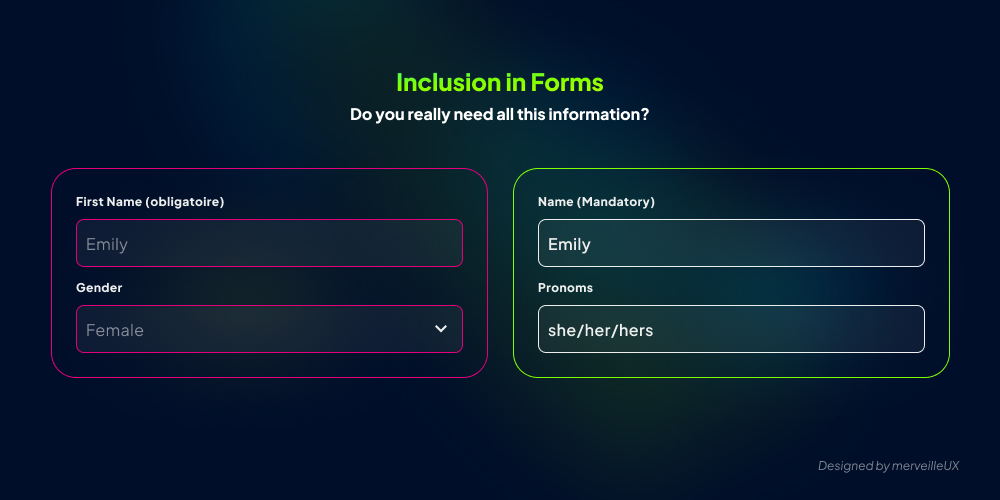June's here, and so are the rainbow logos – some more convincingly than others. It's a gesture. But let's get down to brass tacks: pair "Pride Month" with "SaaS business strategy," and you'll see some decision-makers cringe faster than at an unplanned downtime. Another hit to the roadmap, another 'nice-to-have' distraction? Here's a thought: what if this whole inclusion thing wasn't a drag, but one of those overlooked, seriously effective levers to make users genuinely stick with your product and get your own teams feeling more invested and proud? Hold on, because what lies beyond the performative rainbow might just be your next competitive edge.
Table of contents
Inclusive Design for SaaS: Small Changes, Big Impact for Your Product's Users
Let's be frank: nobody likes to feel invisible or misunderstood, especially by software that's supposed to make their life easier. If your SaaS seems to be making wild guesses about who your users are, or worse, shoehorns them into boxes that just don't fit, that initial excitement can evaporate faster than a good idea in a meeting-packed day. The goal? To create an experience where everyone feels seen and considered, without rolling their eyes at every form field.
Spoiler alert: it's good for business.
Inclusive Forms: More Than Just Fields to Fill
Ah, forms! That often-dreaded first contact. Yet, this is where you can score major points (or lose them) by showing you've thought about everyone – or at least, more than just two types of people.
- Gender & Salutations – The Dynamic Duo: The classic "Mr./Ms." and "Male/Female" options have had their day. Offering choices like "Prefer not to say," a free-form field for gender, or the neutral salutation "Mx." isn't revolutionary; it's just... common sense these days. Even better: ask yourself if you really need that info. The less you ask, the better for privacy compliance (and the faster the form gets filled). Many U.S. companies are moving towards this. For instance, the HRC Corporate Equality Index highlights that 98% of all CEI-rated businesses now offer explicit gender identity non-discrimination protections, up from just 5% in 2002. (*)
- Pronouns – The Small Detail That Changes Everything: A field for pronouns (he/him, she/her, they/them, etc.)? It's a sign your product isn't living under a rock. This is especially true when data shows a significant portion of the workforce, particularly younger generations like Gen Z (where nearly 30% identify as LGBTQ+ according to HRC (*)), values this recognition. It allows for correct addressing in automated communications, and that’s basic respect.

SaaS-Speak Without Alienating: The (Not-So-Complicated) Language Challenge
Your product talks. Notifications, emails, tooltips... so many chances to get it right, or to completely miss the mark. Nobody wants to read "Dear Sir," (masculine by default, naturally) over and over.
- The Magic of Neutrality: "The team" instead of "the collaborators," "Your account" instead of "The user's account." Simple, effective UX Writing.
- Inclusive Language, Without Overdoing It: No need to rewrite the dictionary. Gender-neutral phrasing or smart reformulations often do the trick to make everyone feel included.
- Simple and Clear is Key: Accessible language benefits everyone, including those for whom your SaaS's primary language isn't their first.
The Takeaway: Clear, inclusive language isn't just for show; it’s to ensure your message lands and your users feel good.
Visual Representation in Your SaaS Product: What Are You Showing?
If the only images your SaaS product offers are stock photos or AI-generated pics of men in suits shaking hands, there might be an issue. Visuals matter, and they speak volumes.
- Avatars and Illustrations: Variety is the Spice of Life! If your users have avatars, offer options beyond "Ken or Barbie." Think diversity in gender, ethnicity, and style. Same for your illustrations: the world is diverse, so show it.
- Examples That Speak to Everyone: In your tutorials or demos, if it's always "John does this" and "Emily does that" in stereotypical roles, you're missing a chance to connect with a broader audience.
Bright Idea: When people see themselves (even a little) in your product, they're more likely to adopt it and love it. It's practically free marketing.
In short, making your SaaS product more inclusive on the UX front isn't just for PR or to tick a box on your "Our Values" page. It's a pragmatic approach to improve user experience, boost engagement, and, incidentally, avoid looking like a relic from a bygone era.
When Your SaaS Product Makes Your Clients' Employees Proud
Turns out, the tools a company chooses for its teams say a lot about its culture. A product that breathes inclusion can have a "wow" effect (or at least an "ah, that's good") on internal pride and even on your clients' attractiveness as employers.
Yes, your employees (and your clients' employees) have opinions about the tools they use, and they're not always kind.
The Tool That Whispers: "You're Respected Here"
Picture this: a company promotes values of openness and respect. Then, its employees log into an internal tool that seems straight out of the 90s in terms of diversity awareness. A bit of a disconnect, right?
- More Than Software, It's a Message: When a company provides its teams with software that is clearly inclusive (in its forms, language, visuals), it's not just giving them a work tool. It's saying: "We care about these issues; we want everyone to feel comfortable here." It's a subtle but powerful signal. U.S. companies leading in LGBTQ+ inclusion often see higher employee engagement. The HRC CEI notes that companies with top scores demonstrate a tangible commitment that resonates internally.
- The Pride of Using (and Selling) a Product: Employees, whether from diverse communities themselves or as allies, appreciate using tools that reflect modern values. A sales rep will be more comfortable selling a product they know is respectful, and a manager more at ease deploying it to their team.
The Little Secret: Employees who feel aligned with the tools they're given are (surprisingly) more inclined to use them well.
Employer Branding: Inclusive SaaS, That Little "Extra" That (Sometimes) Makes a Difference
The job market is competitive, especially in tech. Companies fight to attract and retain talent. And guess what? Company values and culture increasingly weigh heavily in candidates' decisions.
- "At Our Company, Even Our Software is Well-Mannered": Being able to say you choose tools that embody inclusion might seem like a detail, but it's concrete proof of commitment. For a candidate sensitive to these issues (and more and more of them are entering the job market, especially Gen Z, it can tip the scales. This is critical, as HRC's "Equality Rising" report showed 26% of LGBTQ+ workers have searched for a different job due to a non-affirming environment.
- Reassure and Retain Internally: For current employees, especially those from LGBTQ+ communities, knowing their company makes conscious and respectful tech choices is a factor in well-being and loyalty. It avoids the "double standard" feeling between official discourse and the reality of daily tools.
What We Often Forget: A work tool is a bit like the office coffee machine. If it's terrible or poorly maintained, people complain. If it's great and there's even oat milk, people smile. Business software is no different.
Productivity: The (Not-So) Invisible Link Between Well-Being and Performance
We're not going to promise that making your gender selector inclusive will double the GDP. But there's a more subtle link between a respectful work environment (including its tools) and team engagement.
- Less Mental Load, More Focus: When you don't have to fight or feel awkward with a tool because of how it addresses you, you have more energy for... well, work. A report by Boston Consulting Group (BCG) cited by HRC found that companies with diverse leadership teams generate 19% more revenue from innovation (*).
- The Positive Effect on Company Culture: An inclusive SaaS product contributes, on its small scale, to spreading a culture of respect and recognition. And a good company culture is generally good for productivity.
Thought for the Day: Employees who feel respected and proud of their company's tools and values are often more motivated. It's not magic; it's basic psychology.
So, there you have it. That SaaS product cuidar of its users by respecting their identity isn't just a UX "nice-to-have." It's an often-underestimated lever that can positively impact your clients' team pride, their company culture, and even their ability to attract new talent. Not bad for a few design tweaks, right? But wait, because the SaaS provider itself also has a big card to play in this story...
More Than a Rainbow Logo: 4 Strategic Reasons to Build Inclusion Into Your Product
Turns out, thinking "inclusion" for your product might be smarter for your business than you think. HRC’s Corporate Equality Index emphasizes that inclusive policies are not just good values; "it's good business." (*)
1. Stand Out in the SaaS Jungle: The "Inclusive by Design" Edge
The SaaS market is, let's put it politely, a tad crowded. To rise above the noise, you need more than a sleek interface and a feature list as long as your arm. "Inclusive by design" can become a real differentiator.
- More Than a Feature, It's a Philosophy: Integrating inclusivity into the core of your product design isn't just adding an option to a dropdown menu. It's showing you have a modern, attentive vision of the real needs of all your potential users. And that sells.
- Meeting a Growing Demand: More and more companies (your potential clients) are incorporating ESG and inclusion criteria into their purchasing processes, including for software. Having a SaaS that natively checks these boxes is a significant competitive advantage. As HRC notes, the CEI is a "roadmap for LGBTQ+ workplace inclusion...a framework for building stronger, more competitive businesses." (*) Companies actively seek these frameworks.
The Killer Pitch: "Our SaaS isn't just powerful and intuitive; it's also designed so every member of your team feels respected and effective." Sounds better than "We have the same features as the others, but cheaper," doesn't it?
2. A Brand Image That Inspires Trust (and Makes People Want to Buy)
Brand image isn't just your logo and color palette. It's the overall perception people have of your company and products. And a product that shows genuine attention to human details inspires trust.
- Modernity and Attention to Detail: A company that refines its product to be inclusive is seen as attentive, rigorous, and in tune with the times. This positively reflects on its entire value proposition.
- Authenticity Pays (More Than "Pride Washing"): Users and businesses are increasingly savvy at spotting "washing" (social, green, pride...). A real commitment, baked into the product itself, is far more credible and valued than an opportunistic marketing campaign once a year. 93% of LGBTQ+ consumers view high CEI scores as an indicator of genuine support (*).
The Simple Truth: People prefer to buy from companies they respect and that seem to share their values (or at least, don't actively go against them).
3. Anticipate Tomorrow's Expectations (and Avoid Playing Catch-Up)
What's considered a "best practice" or a "plus" in software inclusion today will likely become a standard expectation, or even a requirement, in a few years.
- Get Ahead of the Curve: By integrating these principles now, you position your product as a leader rather than a follower. It's always better than having to scramble to catch up when competition or legislation forces your hand.
- Future-Proof Your SaaS: Designing for diversity today makes your product more robust and adaptable to future changes in user needs and societal norms.
What History Teaches Us: Web accessibility was a niche 20 years ago. Today, it's a legal and ethical imperative. Inclusion might just be on the same path.
4. Broaden Your Horizons: Speak to a Wider Audience (and Their Allies)
Even if LGBTQ+ communities represent a "niche" for some products, the impact of inclusive design goes far beyond. And that "niche" isn't so small: Gallup polls indicate around 7-8% of U.S. adults identify as LGBT, and as HRC notes, for Gen Z adults, it's closer to 30% (*). This is a significant market segment and user base.
- The Ally Ripple Effect: People allied with LGBTQ+ causes (friends, family, colleagues) are also sensitive to how brands and products handle these topics. Their purchasing power and influence are not negligible. The HRC CEI itself highlights the importance of "Employee Resource Groups for LGBTQ+ workers and their allies." (*)
- Inclusion Benefits Everyone: Often, solutions designed for a specific group improve the experience for all users (think curb cuts also helping strollers and rolling luggage). Flexible, respectful design is universally appreciated. LGBTQ+ consumers alone hold close to $1.4 trillion in spending power in the U.S. (*).
Pragmatic Conclusion: A SaaS product that respectfully addresses a greater diversity of individuals logically has a larger potential market.
Conclusion
So, this Pride Month, it's time to remember that beyond the rainbow marketing, inclusion in your SaaS is ethical design, and it's serious business. Not the kind of serious that makes you want to run for the hills, but the kind that can genuinely boost your user experience, make your clients' teams a little prouder of their tools, and incidentally, help you stand out in a crowded market.
Simply put: more engaged users, a better brand image (for you and your clients), and a head start. Not bad, right?
To get started without the headache: begin with listening and empathy, conduct a small audit to see clearly, and think "system" for consistency. Every step counts.
Inclusion is year-round. And if you're looking for a hand to turn ideas into interfaces, we're here. No fluff, just UX that makes sense.
(*) Data points marked with an asterisk are inspired by or drawn from sources like the Human Rights Campaign Corporate Equality Index 2025, Gallup, Pew Research, and general U.S. market understanding of D&I trends.



